@Satyaki Banerjee - Nice cables. Btw, what's your opinion / experience with speaker cable capacitance and what cable capacitance would you settle down for? The cables in the image look to me like a high capacitance cable with hot and cold polarity very close and parallel to each other. Have you experienced any low capacitance speaker cable before?
You are using an out of date browser. It may not display this or other websites correctly.
You should upgrade or use an alternative browser.
You should upgrade or use an alternative browser.
Fostex 126 En + Eminence Beta 12 A 2 Full Range Speaker System
- Thread starter Satyaki Banerjee
- Start date
Satyaki Banerjee
Well-Known Member
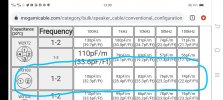
The above is the snapshot of the capacitance values of the Mogami W3103 speaker cables. I believe they have a nice balance of resistance, inductance and capacitance.
- DC Resistance (20°C): 0.005Ω/m(0.0015Ω/Ft)
- Inductance (1kHz, 20°C) 1-2: 0.6µH/m (0.18µH/Ft)
I have a fairly limited experience with speaker cables. For the first 3 projects that were single full range driver BLH speakers paired with 2A3 SET amplifier, I used solid core copper cables. They seemed the perfect match to my ears. Focused, natural and full bodied sound.
When I shifted to a 2 way design using a 12 inch bass driver, I felt it sounded better with stranded wire. I used 12 AWG Supra classic cables for external wiring and 14 AWG for internal wiring. Supra cables use tin plated copper. Somewhere I had the feeling that it adds a slight colour to the sound, though for all these years I was liking it.
Now that I am starting a new speaker project, I decided to use stranded but pure copper cables. Mogami cables are known to be absolutely neutral sounding, partly due to their legacy of making cables for Studio applications. I have always used Mogami 2803 RCA interconnects and the speaker cables harmonizes the entire chain.
These are quite impressive. They give around 80 ohms characteristics impedance which still is very high compared to speaker impedance.The above is the snapshot of the capacitance values of the Mogami W3103 speaker cables. I believe they have a nice balance of resistance, inductance and capacitance.
- DC Resistance (20°C): 0.005Ω/m(0.0015Ω/Ft)
- Inductance (1kHz, 20°C) 1-2: 0.6µH/m (0.18µH/Ft)
IME, using the right cable is everything in audio. An inch of bad wire can ruin the entire music experience.I have a fairly limited experience with speaker cables. For the first 3 projects that were single full range driver BLH speakers paired with 2A3 SET amplifier, I used solid core copper cables. They seemed the perfect match to my ears. Focused, natural and full bodied sound.
When I shifted to a 2 way design using a 12 inch bass driver, I felt it sounded better with stranded wire. I used 12 AWG Supra classic cables for external wiring and 14 AWG for internal wiring. Supra cables use tin plated copper. Somewhere I had the feeling that it adds a slight colour to the sound, though for all these years I was liking it.
Now that I am starting a new speaker project, I decided to use stranded but pure copper cables. Mogami cables are known to be absolutely neutral sounding, partly due to their legacy of making cables for Studio applications. I have always used Mogami 2803 RCA interconnects and the speaker cables harmonizes the entire chain.
Sean de Silva
Well-Known Member
Absolutely true! IME too, changing the power and speaker cable has made a very discernible difference.IME, using the right cable is everything in audio. An inch of bad wire can ruin the entire music experience.
@Satyaki Banerjee
Do you consider characteristics impedance of speakers or interconnects when connecting source and destination? Since we are DIY guys it will be possible for us to do this matching unlike commercial products.
I very recently have tried matching characteristics impedance of my interconnect cables from my pre amplifier to power amplifier. I have added some series resistors and parallel capacitors to achieve this match. I am already liking what I am listening. The obvious difference was reduced edging and distortion. Now my next DIY activity is do this match for the speakers too.
Agreed many don't believe that matching cables to source and destination loads are required for short cable runs as the loss will be miniscule if any. But again I am listening better audio with this match. I have not noticed any gain or attenuation of signal due to this matching.
Based on my speaker cables measured value it's current CI is around 62 ohms. I need to reduce that to around 4 ohms for my speakers. I will need to add some resistors, capacitors across the terminals to match this.
Applied this wisdom to my speaker cables - I have seen similar techniques used in ex-FM mpw Merlin speakers.
Do you consider characteristics impedance of speakers or interconnects when connecting source and destination? Since we are DIY guys it will be possible for us to do this matching unlike commercial products.
I very recently have tried matching characteristics impedance of my interconnect cables from my pre amplifier to power amplifier. I have added some series resistors and parallel capacitors to achieve this match. I am already liking what I am listening. The obvious difference was reduced edging and distortion. Now my next DIY activity is do this match for the speakers too.
Agreed many don't believe that matching cables to source and destination loads are required for short cable runs as the loss will be miniscule if any. But again I am listening better audio with this match. I have not noticed any gain or attenuation of signal due to this matching.
Based on my speaker cables measured value it's current CI is around 62 ohms. I need to reduce that to around 4 ohms for my speakers. I will need to add some resistors, capacitors across the terminals to match this.
Applied this wisdom to my speaker cables - I have seen similar techniques used in ex-FM mpw Merlin speakers.
Last edited:
Satyaki Banerjee
Well-Known Member
Thanks Hari. That's a very interesting article.
Satyaki Banerjee
Well-Known Member
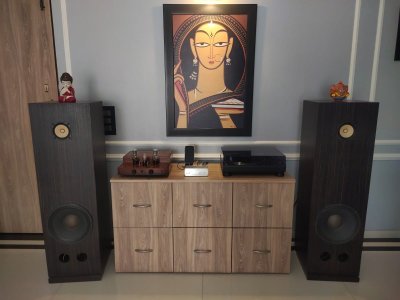
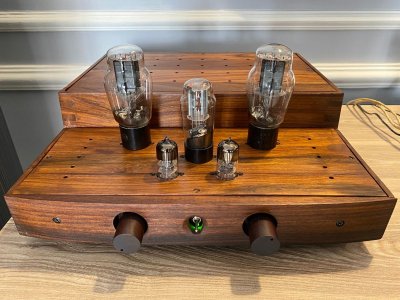
The Leak Amplifier makes way for a 2A3 amplifier made by Viren Bakshi. I have owned two versions of his 2A3 amplifier in the past. A 2A3 integrated as well as a full DHT pre-power.
The current version is the simplest of the three. It is a two stage amplifier with Soviet 6S4P-DR input tubes, NOS RCA grey plate 2A3 power tubes and Soviet 5C4S rectifier tube.
This is a brilliant sounding amplifier and I prefer this over all the Lyrita 2A3 versions I have owned / heard in the past.
View attachment 77720
View attachment 77721
The Leak Amplifier makes way for a 2A3 amplifier made by Viren Bakshi. I have owned two versions of his 2A3 amplifier in the past. A 2A3 integrated as well as a full DHT pre-power.
The current version is the simplest of the three. It is a two stage amplifier with Soviet 6S4P-DR input tubes, NOS RCA grey plate 2A3 power tubes and Soviet 5C4S rectifier tube.
This is a brilliant sounding amplifier and I prefer this over all the Lyrita 2A3 versions I have owned / heard in the past.
What is the difference in the sound of the Leak and this Lyrita?
Satyaki Banerjee
Well-Known Member
The Leak is a very good sounding amplifier. However in comparison the Lyrita 2A3 sounds more organic, full bodied and involving.What is the difference in the sound of the Leak and this Lyrita?
grindstone
Active Member
Lovely rig & a really good approach to a speaker if the level-matching and slopes can work-out (and of course the size). Applaud the time and effort to focus on matching. I lost at least 10 years on those little drivers so I have an idea of what you've hatched. Thanks for posting updates.
Satyaki Banerjee
Well-Known Member
This Christmas Santa is gifting me a Thoress F2A11 amplifier coupled with a new DIY speaker and Exclusive P10 turntable in DIY plinth with Denon DL 103 and EAR Phono.
souravin
Well-Known Member
Congratulations Satyaki. All state of the art audio equipment are getting in one pool. I'm sure ,your deep thought basis the your genre and liking, is behind this wonderful association. Do post pictures and first impression of music - the ultimate objectiveThis Christmas Santa is gifting me a Thoress F2A11 amplifier coupled with a new DIY speaker and Exclusive P10 turntable in DIY plinth with Denon DL 103 and EAR Phono.
Satyaki Banerjee
Well-Known Member
Thanks @souravin.
My speaker setup is now complete. Here are a few photographs.
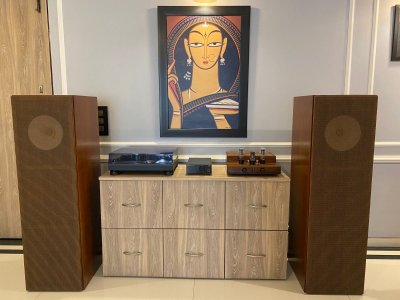
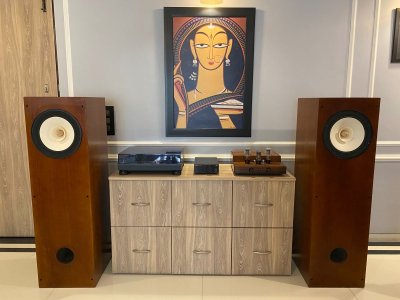
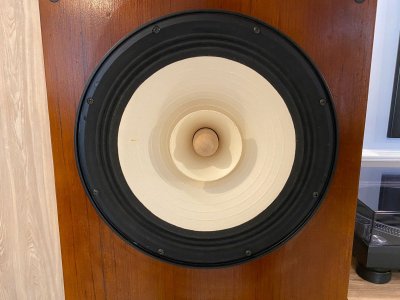
It's a single driver speaker, using a 12 in Alnico wide band driver manufactured by Ishtvan Varga of Sonido, Hungary. A very knowledgeable and helpful gentleman making very nice drivers.
The cabinet was designed by me and masterfully executed by FM @sadik.
A big thanks to FM @prem for his constant guidance and inputs.
The speaker alignment chosen for this project is SBB4 that works very well with low Qt drivers like this one.
It's a very simple and musical speaker.
My speaker setup is now complete. Here are a few photographs.



It's a single driver speaker, using a 12 in Alnico wide band driver manufactured by Ishtvan Varga of Sonido, Hungary. A very knowledgeable and helpful gentleman making very nice drivers.
The cabinet was designed by me and masterfully executed by FM @sadik.
A big thanks to FM @prem for his constant guidance and inputs.
The speaker alignment chosen for this project is SBB4 that works very well with low Qt drivers like this one.
It's a very simple and musical speaker.
souravin
Well-Known Member
Simply a Wooow. A great audio composition and ideated & crafted by a pool of stalwarts. Your last statement says it all- a simple and musical speaker. That's the end objective which varies with the taste of the listener.Thanks @souravin.
My speaker setup is now complete. Here are a few photographs.
View attachment 88778View attachment 88779View attachment 88780
It's a single driver speaker, using a 12 in Alnico wide band driver manufactured by Ishtvan Varga of Sonido, Hungary. A very knowledgeable and helpful gentleman making very nice drivers.
The cabinet was designed by me and masterfully executed by FM @sadik.
A big thanks to FM @prem for his constant guidance and inputs.
The speaker alignment chosen for this project is SBB4 that works very well with low Qt drivers like this one.
It's a very simple and musical speaker.
Not only that, this clutter free and soothing aesthetics bring peace of mind and less distraction during listening. The concentration is on music only. Lovely and some day I wish to visit and listen.
Had a chat with @hector2013 as our listening taste is very similar and he says it's captivating and superb. Wishing you endless joy from the new rig. I was wondering how a Asha B and Pancham bengali LP (say Rashmi Churi or Phire Elam) will be emerging from this audio rig.
Satyaki Banerjee
Well-Known Member
Thanks @souravin.Simply a Wooow. A great audio composition and ideated & crafted by a pool of stalwarts. Your last statement says it all- a simple and musical speaker. That's the end objective which varies with the taste of the listener.
Not only that, this clutter free and soothing aesthetics bring peace of mind and less distraction during listening. The concentration is on music only. Lovely and some day I wish to visit and listen.
Had a chat with @hector2013 as our listening taste is very similar and he says it's captivating and superb. Wishing you endless joy from the new rig. I was wondering how a Asha B and Pancham bengali LP (say Rashmi Churi or Phire Elam) will be emerging from this audio rig.
It will be an absolute pleasure hosting you whenever you are in Mumbai.
My turntable plinth is almost ready, I will soon report back with update on how it sounds.
Satyaki Banerjee
Well-Known Member
I recently designed a speaker for FM @Soulsatisfaction using a 7 inch Alnico Wide Band driver supported by a 12 inch Alnico Bass driver. The 7 inch Wide Band driver was placed in a sealed chamber of Qtc of 0.5 and SBB4 alignment was used for the 12 inch bass driver.
The drivers were made by Ishtvan Varga of Sonido, Hungary and the enclosure design was executed by our very own master craftsman @sadik.
The crossover is as simple as it gets, a single capacitor and an aircore inductor.
Posting some photographs:
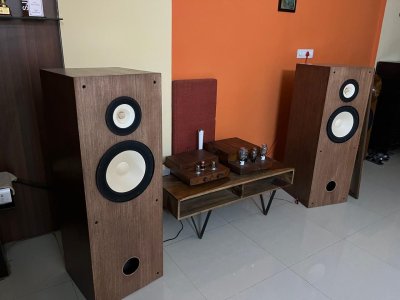
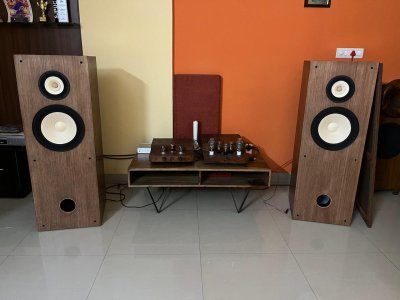
FM @Soulsatisfaction can give details of his chain and listening impression.
The drivers were made by Ishtvan Varga of Sonido, Hungary and the enclosure design was executed by our very own master craftsman @sadik.
The crossover is as simple as it gets, a single capacitor and an aircore inductor.
Posting some photographs:


FM @Soulsatisfaction can give details of his chain and listening impression.
Last edited:
Please do share the cost for this buildI recently designed a speaker for FM @Soulsatisfaction using a 7 inch Alnico Wide Band driver supported by a 12 inch Alnico Bass driver. The 7 inch Wide Band driver was placed in a sealed chamber of Qtc of 0.5 and SBB4 alignment was used for the 12 inch bass driver.
The drivers were made by Ishtvan Varga of Sonido, Hungary and the enclosure design was executed by our very own master craftsman @sadik.
The crossover is as simple as it gets, a single capacitor and an aircore inductor.
Posting some photographs:
View attachment 88789
View attachment 88790
FM @Soulsatisfaction can give details of his chain and listening impression.
souravin
Well-Known Member
I recently designed a speaker for FM @Soulsatisfaction using a 7 inch Alnico Wide Band driver supported by a 12 inch Alnico Bass driver. The 7 inch Wide Band driver was placed in a sealed chamber of Qtc of 0.5 and SBB4 alignment was used for the 12 inch bass driver.
The drivers were made by Ishtvan Varga of Sonido, Hungary and the enclosure design was executed by our very own master craftsman @sadik.
The crossover is as simple as it gets, a single capacitor and an aircore inductor.
Posting some photographs:
View attachment 88789
View attachment 88790
FM @Soulsatisfaction can give details of his chain and listening impression.
Fantastic. This is an ideal speaker for us, bolywood oldies fanatics, wherein mids and punch should go hand in hand. Lovely conglomeration
Soulsatisfaction
Member
Thanks Satyaki and Sadik for helping me in creating these beautiful sounding speakers.I recently designed a speaker for FM @Soulsatisfaction using a 7 inch Alnico Wide Band driver supported by a 12 inch Alnico Bass driver. The 7 inch Wide Band driver was placed in a sealed chamber of Qtc of 0.5 and SBB4 alignment was used for the 12 inch bass driver.
The drivers were made by Ishtvan Varga of Sonido, Hungary and the enclosure design was executed by our very own master craftsman @sadik.
The crossover is as simple as it gets, a single capacitor and an aircore inductor.
Posting some photographs:
View attachment 88789
View attachment 88790
FM @Soulsatisfaction can give details of his chain and listening impression.
Puting words will not be enough but I can say it’s meditation for me listening these speakers and one must listen the musicality of these speakers.
With my Lyrita 300b full DHT amp these are creating magic.
They are very easy to drive speakers.
Someone looking for to have feel of these speakers can come to my place in Bangalore.
These are quite big and big sounding speakers. I am enjoying listening.
Soulsatisfaction
Member
A small update. I have changed my drivers from 45 to 2a3. Magic happened with my existing Denon CD player and NOS Teradak. I am using my old Jamo cable not easy to get now.Thanks Satyaki and Sadik for helping me in creating these beautiful sounding speakers.
Puting words will not be enough but I can say it’s meditation for me listening these speakers and one must listen the musicality of these speakers.
With my Lyrita 300b full DHT amp these are creating magic.
They are very easy to drive speakers.
Someone looking for to have feel of these speakers can come to my place in Bangalore.
These are quite big and big sounding speakers. I am enjoying listening.
Sometimes we try to upgrade chain without realising possibilities need to xplore within. May be a slight mismatch is contributing to big frustration.
As far as I experienced if you are okay with existing digital media then Single ended tube amp and high sensitivity speakers is the best combination to experience great music which each artist try to create.
For me this combination is not making me feel that I am missing turntable or Sub woofer to get punch. Even though I know TT can take this to next level.
Now this system is fully ready of someone want to experience the performance. I am waiting for Satyaki also to experience the setup as he himself have not experienced outcome.
Order your Rega Turntables & Amplifiers from HiFiMART.com - India's reputed online dealer.
Similar threads
- Replies
- 3
- Views
- 4K

